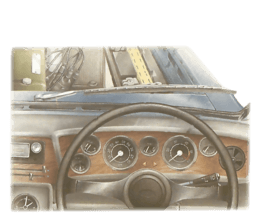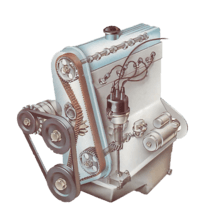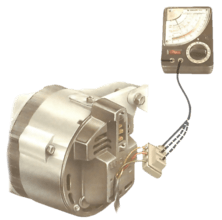Alternators are powerful enough to cope with the demand for current made by a modern car's electrics, but dynamos often are not. So if your car has a dynamo, and its output is inadequate, it makes sense to swap a dynamo for an alternator.
Removing the old dynamo and fitting the alternator are fairly straightforward. The main difficulty is mounting the alternator, because it is a different size from a dynamo, and wiring it in.
Brackets
Disconnect the battery, remove the generator drive belt and take out the dynamo. Wrap, in plenty of insulating tape, the thick wire that ran to the dynamo D terminal so that it cannot touch the bodywork.
This video course is the best way to learn everything about cars.
Three hours of instruction available right now, and many more hours in production.
- 4K HD with full subtitles
- Complete disassembly of a sports car
The rear of the dynamo is mounted to the engine block via a right-angled bracket, one end of which bolts to the block, the other end to a mounting point on the rear casing of the dynamo.
Look to see if there is a second mounting point on the block just forward of the existing one. If there is, you can simply unbolt the mounting bracket from the block, move it forward and bolt it into the new mounting point. You can then mount the alternator in place.
If there is no second mounting point, you have two choices. The easier option is to buy a special, extra-long mounting bracket, bolt this to the engine block in place of the old bracket, then mount the alternator to that. But these brackets are not available for all cars, in which case the alternative is to adapt the existing mounting point to take the alternator.
Move the existing bracket forward to a new mounting point.
Fit an extra-long bracket to the original mounting point.
Extend the alternator mounting point with a length of steel tube.
Simple mounting
If there is a second mounting point on the engine block, or if you can buy and fit a conversion bracket, offer up the alternator to its mounting points.
It should fit snugly, but you may find that the rear mounting point on the alternator does not butt up to the bracket on the block. If so, you need to adjust the alternator's rear mounting. Find the short metal tube on the mounting and use a small hammer to gently knock this tube forwards or backwards until it just touches the mounting bracket. Now bolt the alternator in place.
Use a ruler to check that the pulley is in line with the crankshaft and water pump pulleys. If it isn't, you will have to place washers between the alternator and its front bracket until it is level.
Existing mountings
If you have to use the existing dynamo mounting point, first bolt the alternator to its front mounting point. Check the alignment of the alternator pulley (see above).
Now tap the tube on the rear mounting as far through the bracket as it will go. If it doesn't reach the rear mounting on the engine, cut a length of metal tube to run between the end of the tube and the bracket on the engine.
Fit a long bolt through the rear bracket on the engine and pass it through the piece of tube you cut. Push it through the rear mounting point on the alternator, then fit a washer and nut to it - leave the nut loose for now.
Electrical work
Fit the eye connector end to the starter solenoid.
Fit an eye connection to one end of your cable and a multi-connector plug to the other end. Then attach the eye end to the starter solenoid or battery live terminal and the other end to the ± terminal on the alternator.
Fit the multi-plug end to the alternator + terminal.
Move the small wire from dynamo F to alternator IND.
Join up the dynamo F and WL wires.
Alternator wiring diagram.
Attach the small terminal that fitted to the dynamo F terminal to the alternator IND terminal using the multi-plug.
At the voltage regulator, disconnect the F and WL wires and join them together.
The full wiring diagram, with cable sizes, is shown.
Adjustment
Attach the slotted adjuster strap to the alternator and to its mounting point on the engine. Ensure that the alternator pivots freely.
You may find that you have to bend the slotted strap to make it fit. If that does not work you will need to buy the correct strap for the alternator. Fit a new generator drive belt and tension it correctly.
Wiring up
The alternator needs to be connected to the ignition warning light and to either the input terminal on the starter solenoid or the live battery terminal. Using 97/.012 (97/.30) cable, measure how much you need and cut it to length.
Attach a suitable connector to each end of the cable, and connect it to one of the large terminals in the rear of the alternator marked + (it doesn't matter which one).
Run the cable to your chosen live point following the wiring loom. Use cable ties or insulating tape to secure the cable. Connect the free end of the cable to the starter solenoid or battery terminal.
Now find the small wire that was connected to the dynamo F terminal Connect it to the terminal on the rear of the alternator marked IND. Next move to the voltage regulator unit, and find the terminal marked F or DF and pull off the wire from it.
Do the same with the wire on the WL terminal. Join the two wires together, and insulate them. You can leave all the other wires attached to the voltage regulator - it acts as a useful junction box.
Fit the drive belt and tension it and reconnect the battery. Turn on the ignition, and check that the ignition warning light comes on. Start the car and ensure the light goes out - you may need to blip the throttle for a second to help it.









